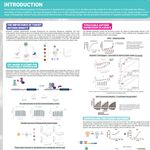Assistant Professor in Environmental Engineering in the Department of Civil, Environmental & Architectural Engineering at the University of Kansas
BIOGRAPHY

JUN 07, 2022 9:00 AM PDT
Deploying SARS-CoV-2 wastewater monitoring in Kansas: A case study and adoption of high-throughput, automated sample processing
Sponsored by: Ceres Nanosciences
Speaker
Event Date & Time
Date: June 07, 2022
Time: 9:00am (PDT), 12:00pm (EDT), 4:00pm (CEST)
Abstract
The COVID-19 pandemic has highlighted the potential role that wastewater-based epidemiology (WBE) can play in assessing aggregate community health. However, efforts to translate SARS-CoV-2 gene copy numbers obtained from wastewater samples into meaningful community health indicators are nascent. This work will highlight two efforts to promote the use of WBE: 1) comparison of SARS-CoV-2 wastewater measurements during a low-frequency and a high-frequency clinical testing period and 2) adoption of automated, high-throughput methods to enable state-wide monitoring in Kansas. These efforts measured the SARS-CoV-2 nucleocapsid (N) genes (N1 and N2) weekly using reverse transcriptase droplet digital PCR. To compare measurements with clinical results, two municipal wastewater treatment plants were monitored for six months. Four biomarkers (human mitochondrial gene NADH dehydrogenase subunit 5 (mit5), creatinine, ammonia, and biological oxygen demand (BOD)) were quantified and used to normalize Sars-CoV-2 gene copy numbers to account for variations in sewershed conditions. The normalized values were correlated to daily new case data and one-, two-, and three-week cumulative case data. Mitochondrial and creatinine normalization methods showed the strongest correlations throughout the studying indicating that human-specific biomarkers were better at normalizing wastewater data than ammonia or BOD. During low-frequency clinical testing periods, results were strongly correlated with a six-day case data lag (ρ = 0.83), while the high-frequency clinical testing period yielded correlations of 0.81 with a one-day case data lag. To expand these efforts to a state-wide monitoring effort, a high-throughput, automated workflow was compared to the original PEG-precipitation method. The transition to a new methodology has allowed for monitoring in 95 out of 105 Kansas counties.
Learning Objectives
- Identify the benefits of SARS-CoV-2 wastewater surveillance as an early warning indicator of an outbreak in communities during infrequent clinical testing periods.
- Provide evidence that suggests SARS-CoV-2 wastewater measurements offer similar community-level health information as high-frequency clinical testing.
- Recognize how an automated workflow can increase capacity and reduce total processing time.
Webinars will be available for unlimited on-demand viewing after live event.
You May Also Like
DEC 10, 2024 | 9:00 AM
To-date, proteomic analysis has been severely limited in scale and resolution. Analyzing protein samples using an intact, single-molecule approach holds th...
APR 21, 2025 | 1:00 PM
C.E. CREDITS
Routine coagulation assays are widely performed in laboratories and provide valuable information to the patient’s overall clinical picture. It’s important for laboratorians to kn...
Speaker:
Malissa S Norfolk, MBA, PMP, MLS(ASCP)ᶜᵐSHᶜᵐ
FEB 25, 2025 | 1:00 PM
C.E. CREDITS
Quality efforts in the clinical laboratory are always under the microscope- a hyper-focus for laboratorians from start to finish. Recognizing the external factors that affect hemostasis test...
Speaker:
Rae Kerlin, BS, MLS (ASCP), NCA
APR 02, 2025 | 11:00 AM
Join this year's poster presenters in the Poster Hall during the Poster Networking Hour, Wednesday, September 20th, from 10:00 AM –11:00 AM PDT , to chat live about their posters a...
MAR 19, 2025 | 11:30 AM
Join this year's poster presenters in the Poster Hall during the Poster Networking Hour, Wednesday, March 5th, from 10:00 –11:00 AM PDT , to chat...
Loading Comments...
Please update your information
Certificate of Attendance
Thank you for choosing Labroots. Please note that a Certificate of Attendance does NOT count towards Continuing Education Credits.
DOWNLOAD CERTIFICATE
DOWNLOAD CERTIFICATE
You must watch the entire webinar to receive your certificate of attendance.
You must attend the event before receiving your certificate of attendance.
You must register for the event first.
Certificate is no longer available for this event.
You must be logged in to retrieve your certificate.
Finish Registering
Attendees
Resources




